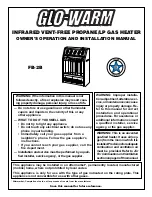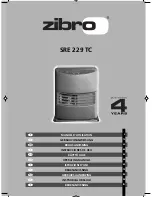
35
Circulator Replacement
1. Shut off electrical power to the heater.
2. Shut off water supply and open drain valve to
remove water in the piping at the pump level.
3. Disconnect wiring and conduit connections to the
pump.
4. Remove the nuts and bolts at the inlet and outlet
flanges. Remove old gaskets.
5. Remove the pump.
6. Reverse the above procedure to re-install. Use
new gaskets and make sure they are seated prop-
erly when tightening the nuts and bolts.
Control Well Replacement
Remove top, sensing bulb and clip. Collapse well tube
at the open end with a chisel, push through into head-
er and remove the well through header. Insert a new
well and roll into place. If a roller is not available, sol-
der the well in place with silver solder.
Tube Replacement Procedure
1. Remove heat exchanger from heater following
instructions outlined under HEAT EXCHANGER
REMOVAL.
2. Remove inlet/outlet and return headers. Remove
"V" Baffle from damaged tube.
3. Remove damaged tube by cutting with a hack saw
or shearing with a chisel adjacent to each tube
sheet.
4. Collapse stub ends in tube sheets using a chisel or
screwdriver. DO NOT cut into tube sheet or mar
surface in tube hole in any way.
5. Insert replacement tube by inserting the end with
the most fins removed in the opening of one tube
sheet. Slide tube until the opposite end clears the
other tube sheet and fits the tube into the hole.
6. Insert the tube roller into tube opening up to stop,
making certain that 1/8" of tube projects beyond
the tube sheet.
7. Attach drill to tube roller, holding it straight and
level.
8. Reverse drill motor and withdraw tube roller, if
necessary wrench out by hand.
9. DO NOT apply excessive torque during rolling
operation and avoid thinning any wall of the tube
beyond 0.015".
10. Use same procedure on opposite end.
11. Apply line pressure test. Re-roll if necessary.
12. Reinstall as outlined under HEAT EXCHANGER
REASSEMBLY.
Procedure for Cleaning Flue Gas
Passage Ways
Soot will clog areas behind fins and eventually cause
tube failure. Any sign of soot at base of burners or
around outer jacket indicates a need for cleaning.
1. Lift off draft hood and flue collector by removing
bolts and screws.
2. Remove "V" baffles from heat exchanger.
3. Remove burner tray, see Burner Drawer Removal.
4. Take garden hose and wash heat exchanger, mak-
ing sure soot is removed from between fins. (Avoid
excessive water against refractory).
5. Reassemble; when heater is fired, some steam
will form from wet refractory, which is normal.
Replacement Parts
Any part returned for replacement under standard
manufacturer warranties must be properly tagged with
a return parts tag, completely filled in with the heater
serial number, model number etc., and shipped to the
manufacturer freight prepaid.
If the manufacturer determines the part is defective
and within warranty, the part will be returned in kind or
equal substitution, freight collect. Credit will not be
issued.
RAYPAK, INC.
2151 Eastman Avenue
Oxnard, CA 93030
CAUTION:
To avoid damage to electrical compo-
nents keep water from getting into the control
compartments and gas valve.
NOTE:
Use a 3/8 in. heavy duty, reversible, electric
drill or larger. Proceed to expand tube until tool starts
to grab. Approximately 1/2 to 1 in. of the tool shank
will be visible.
NOTE:
In extreme cases it may be necessary to
remove the heat exchanger completely for cleaning.
The simplest method is steam cleaning at a local car
wash.
CAUTION:
Soot is combustible. Exercise extreme
care. Do not wire brush.
Summary of Contents for 2600401
Page 17: ...17 Wiring Diagrams Fig 15 Standing Pilot Model 0260 FIELD INSTALLED...
Page 18: ...18 Fig 16 Intermittent Ignition Device IID Model 0260...
Page 19: ...19 Fig 17 Intermittent Ignition Device IID Models 0330 0400...
Page 20: ...20 Fig 18 Intermittent Ignition Device IID Model 0261 Low NOx...
Page 21: ...21 Fig 19 Intermittent Ignition Device IID Models 0331 0401 Low NOx...
Page 37: ...37...
Page 38: ...38...
Page 39: ...39...






































